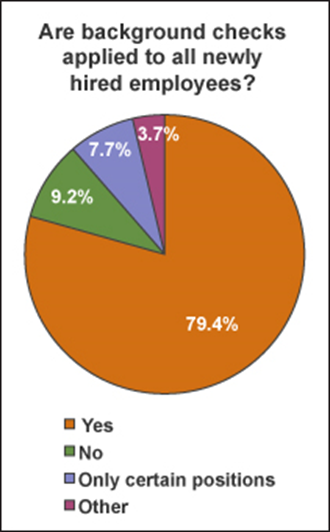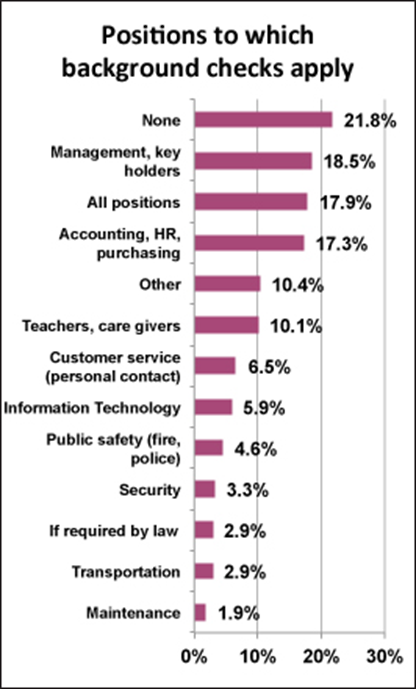Yesterday’s Advisor covered survey results for policy development and distribution; today, policy enforcement and background checks.
 |
Policy Focus: Background Checks
Multiple states and cities have enacted laws in recent months that govern the use of background checks, so this year’s survey takes a closer look at those policies. We kicked it off by asking how many survey participants have background check policies (74.4%) then moved on to ask how many apply background checks to all newly hired employees and found that 79.4% use them. We learned a few other things about background checks as well, including:
- HR staff checks work references only, 26.6%
- HR staff conducts criminal and/or credit background checks, 23.9%
- Outside vendors conduct criminal and/or credit background checks, 66.5%

Social Media Background Checks
Social media is used to check out potential new hires by 14.7% and used sometimes by 20%. Various social media sites are utilized with LinkedIn topping the list at 67%, followed by Facebook at 60.8%, and Google at 34.5%.
Positions Requiring Background Checks
When it comes to which positions require background checks, accounting, HR, key holders, management, and purchasing positions cover 35.8%. All positions are required for 17.9%, and none are required for 21.8%.

A look at the survey participants that use outside vendors to conduct their background checks reveals that 10.4% use ADP, and 9.5% use Hire Right. Making it easier for employers to utilize their services, background check vendors’ systems integrate with employers’ ATS (Applicant Tracking System) for 28.2% and with their HRIS (Human Resource Information System) for 30.9%.
When asked how likely they’d recommend their background check vendor, 46.5% would and 30.4% probably would recommend their service provider. Another 17.7% might make a recommendation and 5.4% absolutely would not.
Managing an HR Department of One was recently recognized as one of SHRMStore’s “Great 8” best-selling products. Find out what all the buzz is about. (New California version available. Click here.)
Policy Enforcement
Policies are enforced somewhat effectively for 51.7% and very effectively for 42.6% of survey participants. Another 5.3%, however, indicate that policies are not effectively enforced.
Management team members’ tendency to enforce only some policies is a problem for 32.3%. Some team members’ practice of not bothering to enforce any policies, however, is cited by 51.9% of survey participants as the biggest stumbling block to overall policy enforcement. The need to update policies is a stumbling block for 29.3%, and having policies that are difficult to understand is an issue for 9.2%. Retaining policies that should be canceled is a stumbling block for 7.2%, and inadequate or lack of distribution is a problem for 6.8%.
Progressive discipline is utilized for some violations of policy for 54.7% and for all policy violations for 37.2%. It is never utilized, however, for 5.2%.

How to Enhance Enforcement
Survey participants indicated that more successful enforcement of policies could be enhanced by:
- More training, 39.4%
- More consistent implementation and/or discipline, 17.6%
- Greater support from management team members, 15.2%
- Accountability for the management team, 16.8%
- Better communication of policies, 9.3%
- Updated and/or better written policies, 6.2%
- Bring HR into the loop earlier, 3.1%
Survey Participants
A total of 2,262 individuals participated in this survey, which was conducted in July 2014. Of those who identified themselves, 62.2% are privately owned for-profit organizations; 17.8% are private, not-for-profit companies; 8.6% are public sector; and 8.5% are government entities.
Companies with 1 to 250 employees account for 60.1% of survey participants. Companies with 251 to 500 employees make up 13.6%, and organizations with 501 to 1,000 comprise 9.1%. Rounding out the group, companies with 1,001 to 5,000 employees account for 11.3%, and organizations with more than 5,000 employees account for 5.9% of survey participants.

Fewer than 9% of the employers surveyed have a 50% to 100% unionized workforce. Also, 78.4% have a workforce with no union representation. Fewer than 23% of the respondents have a workforce of more than 50% exempt employees.
Just over half (51.6%) of the participants are in service industries; 21.7% are in agriculture, forestry, construction, manufacturing, or mining; 6.8% are in wholesale, retail, transportation, or warehousing; and 19.9% are in real estate, utilities, or “other.”
Staff-level employees account for 13.7% of the survey participants who self-identified, and supervisors represent 4.9%. Manager-level survey participants account for 56.9%, and VP or higher represent 24.4%.
What policies to have, what to put in them … a continuing challenge for HR, and in a small department, it’s just that much tougher.
BLR’s Managing an HR Department of One is unique in addressing the special pressures small HR departments face. Here are some of its features:
- Explanation of how HR supports organizational goals. This section explains how to probe for what your top management really wants and how to build credibility in your ability to deliver it.
- Overview of compliance responsibilities through a really useful, 2-page chart of 23 separate laws that HR needs to comply with. These range from the well-known Fair Labor Standards Act (FLSA), Family and Medical Leave Act (FMLA), and new healthcare reform legislation to lesser-known but equally critical rules, such as Executive Order 11246. Also included are examples of federal and state posting requirements. (Proper postings are among the first things a visiting inspector looks for—especially now that the minimum wage has been repeatedly changing.)
Feel as if you’re all alone in HR? Take on a partner—Managing an HR Department of One. Get more information. (New California version available. Click here.)
- Training guidelines. No matter the size of your company, expect to conduct training. Some of it is required by law; some of it just makes good business sense. Managing an HR Department of One walks you through how to train efficiently and effectively with a minimum of time and money.
- Prewritten forms, policies, and checklists. These are enormous work savers! Managing an HR Department of One has 46 such forms, from job applications and background check sheets to performance appraisals and leave requests, in both paper and PDF format.
If you’d like a more complete look at what Managing an HR Department of One covers, click the Table of Contents link below. Or, better yet, take a look at the entire program.
We’ll send it to you for 30 days’ evaluation in your own office with no obligation to buy. Click here, and we’ll be happy to make the arrangements.
Special Announcement! The new California edition is available here!

Hi I was just terminated from steel coatings for a positive drug test that was inconclusive and the next test was negative I have asked steel coatings for 4 years now for a copy of all the policy with no luck Kent Seeley would never get me the information I asked for when all this time I never new what the policy or rules or even when break times was. Now Kent said that I’m terminated and he lost control and his anger took over. I tried my hardest to calmly talk to him and tell him I don’t know or have never seen the policy’s. I don’t think it’s fair that I’m the third person to have a positive drug test but the only one who got terminated I tried to talk to him I tried to tell him I would take and pay every day, week, month for updated testing but he could not stop yelling and swearing and sometimes spitting on me. Is this the way a plus handles this situation to just completely terminate when I never got a copy of any policy’s. Please help me out. At least can I get some feedback with out yelling or spitting on me